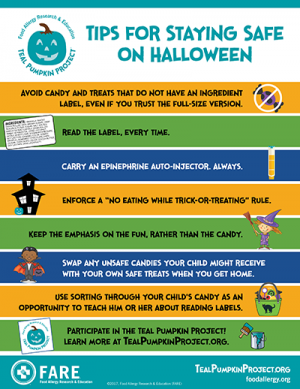Food Allergy Research & Education Encourages Inclusion, Promotes Safety Through the Teal Pumpkin Project®
FARE Provides Key Safety Tips as Annual Awareness Campaign Continues to Grow Nationwide
FARE Provides Key Safety Tips as Annual Awareness Campaign Continues to Grow Nationwide
McLEAN, VA. (Oct. 26, 2017) – From coast to coast, teal pumpkins are making Halloween more fun and inclusive for millions of children with food allergies and other dietary restrictions thanks to the Teal Pumpkin Project®, an annual awareness campaign from Food Allergy Research & Education (FARE).
Only in its fourth year as a national initiative, the Teal Pumpkin Project has become a household tradition for many families across the United States. This year, word of the Teal Pumpkin Project has reached millions of people through social media as well as through partnerships with national retailers who have shown their support for children with food allergies.

“It has been absolutely amazing to see families continue to embrace the Teal Pumpkin Project, whether they are personally affected by food allergies or not,” said Lois A. Witkop, Chief Advancement Officer at FARE. “We know that it’s making a difference in so many lives and we are thrilled to grow this campaign on behalf of children who have food allergies, which are potentially life-threatening.”
New in 2017, FARE sent customized Teal Pumpkin Project kits to 225 elementary schools in underserved neighborhoods in Ann Arbor, Boston, Chicago, Dallas, Denver, Indianapolis, San Diego and San Francisco as part of its community engagement initiative. The program aims to inform students, parents and school personnel who may have limited access to allergists and food allergy education.
It is estimated that more than 40 million children nationwide go trick-or-treating annually in their neighborhood and during special Halloween events in their local communities. The Teal Pumpkin Project is not intended to replace the tradition of giving out candy on Halloween. Many families across the country will have available both candy and non-food treats for trick-or-treaters. To help promote a safe experience, FARE suggests that families who are giving out candy in addition to non-food treats keep sweet treats in a separate bowl or container from non-food treats.
FARE also recommends families managing food allergies keep the following safety tips in mind:
- Enforce a “no eating while trick-or-treating” rule, so that you have time to review all food labels.
- Avoid candy and treats that do not have an ingredient label.
- Always have an epinephrine auto-injector available, if prescribed.
- Keep in mind that the mini-size, fun-size, or bite-size version of candy may contain different ingredients than their full-size counterparts. Make no assumptions, and read all labels carefully.
- Keep the emphasis on the fun, rather than the candy.
- Remember that a candy that has been safe for your child in the past may now have different ingredients. Read the label every time.
The Teal Pumpkin Project was inspired by an idea from the Food Allergy Community of East Tennessee (FACET), led by support group leader Becky Basalone, who originated the idea to paint a pumpkin teal and place it on the porch to let children with food allergies know they would have a safe treat at that home.
It’s not too late to participate – with a few simple steps, anyone can join the Teal Pumpkin Project:
- Provide non-food treats for trick-or-treaters
- Paint a pumpkin teal or buy a teal pumpkin at your local craft store or pharmacy, or print a free sign from www.tealpumpkinproject.org
- Place your teal pumpkin or sign in front of your home to indicate non-food treats are available.
FARE thanks the following Teal Pumpkin Project official 2017 partners: Ahold USA (including its brands Stop & Shop, Giant Food and Giant/Martin’s), CVS Pharmacy, DBV Technologies, FunWorld, Hy-Vee, Learning Express, Magic Power, Market Street, Mello Smello, Michaels, Savers (doing business as Savers, Value Village, Unique and Village des Valeurs) and SCS Direct.
For more information about the Teal Pumpkin Project, visit www.tealpumpkinproject.org. For more information about food allergies, visit www.foodallergy.org.
Media Contact:
About FARE (Food Allergy Research & Education)
FARE (Food Allergy Research & Education) is the leading nonprofit organization that empowers the food allergy patient across their journey of managing the disease. FARE delivers innovation by focusing on three strategic pillars—advocacy, research, and education. FARE’s initiatives accelerate the future of food allergy through effective policies and legislation, novel strategies toward prevention, diagnosis, treatment and a cure, while building awareness and community. To learn more, visit FoodAllergy.org.


